A century ago, the future for wildlife was looking bleak. Once common species like white-tailed deer, wild turkeys, elk, and waterfowl were teetering on a precipice from which the passenger pigeon had so recently fallen. But Americans, facing a future without wildlife, rallied to find creative ways to fund conservation efforts that pulled these species back from the edge.
By dedicating excise taxes on hunting and fishing equipment (as well as revenues from license fees and permits) for conservation, state fish and wildlife agencies were able to recover many game populations. Today, 80 percent of state fish and wildlife agency budgets comes from hunters and anglers. This model of funding conservation has been successful for decades, but this funding model has reached its limits.
While some of the wildlife that were once on the edge are thriving, many others are facing increasing challenges and are in steep decline. Emerging diseases, invasive species, and extreme weather threaten wildlife at a scale inconceivable just a few decades ago. Thousands of species of birds, mammals, fish, frogs, turtles, butterflies, and plants are slipping through the cracks. In many cases, no action is taken until a species is officially listed under the federal Endangered Species Act, a bill originally intended to be an “emergency room” measure. Once a species reaches that point it is much harder and more expensive to recover.
All Americans benefit from healthy fish and wildlife populations – proactive wildlife conservation is good for wildlife, good for businesses, and good for taxpayers. Healthy lands and waters create billions of dollars in economic value. Natural landscapes filter our drinking water, protect communities from storms, and improve our mental and physical well-being. Our nation has a proud history of bringing wildlife back from the brink, like the Bald Eagle, the Grizzly Bear, and the Gray Wolf. It is time to once again make a stand and rally to fund our wildlife legacy.
A bipartisan group in the U.S. House of Representatives drafted the Recovering America’s Wildlife Act (H.R. 5650) that would help avert this crisis. The bill implements the recommendations of the Blue Ribbon Panel on Sustaining America’s Diverse Fish and Wildlife Resources, a nonpartisan panel with representatives from outdoor recreation retailers and manufacturers, the energy industry, sportsmen’s groups, and other conservation organizations.
If enacted, the legislation would dedicate $1.3 billion annually from existing energy and mineral leases on federal lands and waters to states to solve this conservation challenge. The new revenue would be used by each state to safeguard wildlife and their habitat as laid out in existing, but severely underfunded, State Wildlife Action Plans. These plans provide accountability and oversight because they must be updated every ten years with the latest science, require public input, and are approved by the U.S. Fish and Wildlife Service.
This legislation has the potential to be the next victory in the long history of America’s wildlife conservation legacy. The new funding to the states will allow us to proactively conserve the more than 12,000 species that states have identified as being at greatest risk. States could also use a portion of the funds for wildlife-related recreation such as wildlife viewing, nature photography, and trails. And these funds can improve conservation education that will activate the next generation of wildlife stewards, paying dividends far into the future. Importantly, it will also protect the interests of hunters and anglers by ensuring that existing funding streams are used for recovering game species, as originally intended.
In New Mexico this means an additional $27,076,062 for protecting those species the Department of Game and Fish have identified in the State Wildlife Action Plan. Game and Fish is responsible for developing a State Wildlife Action Plan, which identifies imperiled or declining species in the state and lists actions that would assist with their protection and recovery. Currently, the plan identified 1,183 species in need of conservation efforts.
Adequate funding to take proactive steps is the key to conserving wildlife long before they become endangered. Allowing state wildlife agencies to step in earlier will create new jobs, foster regulatory certainty for businesses, and ensure that our children and grandchildren inherit the full diversity of our nation’s fish and wildlife.



